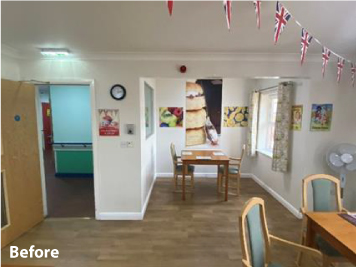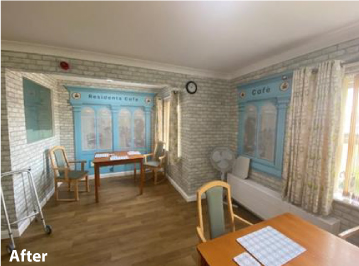Learn more about this role from Find:
We asked one of our long standing specialists to share some details of her role to discover more about the focus and direction of her work and the approach she takes to making a difference in care settings.
If you feel you could make a difference by replicating this in your area, we would be pleased to hear from you.
Karen Clayton
Dementia Specialist
Karen is our Dementia Specialist and has been working at Find Memory Care since September 2009. Being in the role for over 14 years Karen has helped create many dementia friendly environments throughout the UK.
What do like about the job?
I love working with so many passionate individuals who work in dementia care in hospitals and care homes. Passion is infectious and no two environments are the same, so each visit is exciting, looking for the different ways to enhance the environment to help those being supported and cared for.
What motivates you?
Making a positive difference to the environment that enhances the quality of life for those living with dementia.
What changes have you seen in the dementia sector?
Attitude has to be the biggest change. 14 years ago, very few in the care sector had even considered the benefits of an enhanced environment. In fact, most people just thought of dementia as part of the aging process and that little could be done to make life better. Initially, Find promoted a small range of products, in particular dementia-friendly signage to support orientation and independence.
Back then, the evidence demonstrated that simple improvements could reduce incontinence episodes, challenging behaviour and the risk of falls, as knowledge has improved, we now realise how much more can be improved in all environments to support people from early to late-stage dementia and our product range has increased in line with this learning.
Acceptable language and terminology has been a priority over that time – “challenging behaviour” became “behaviours that challenge and distress”, and “suffering with dementia” has become “living (well) with dementia”, just two examples that have been key to changing people’s perception and acceptance of the condition. Training has become essential for staff and new roles have been introduced such as the Admiral Nurses, which is a great move forward and all enhances the quality of care.
What is the greatest challenge you find when creating dementia environments?
Early in my career at Find, I realised how important it was to change my own attitude towards getting things right for others. In dementia care, we all talk about “person-centred care” and I was brought up to believe it was right to treat others as you would want to be treated yourself, but this is far too simplistic.
We are all individual and as such want to be treated as that one unique person. Designing an environment that will work for everyone is certainly a challenge, particularly when space is restricted. We aim to create environments that are as similar to a town or village as possible, offering the same opportunities to all residents. The designs include cafes, pubs, shops, hair salons/barbers, with themes relevant to the location. Homes on the coast may have a seaside theme for example and recognisable local imagery is incorporated for reminiscence and orientation. It is essential that the areas created are as real as possible and do not create false realities. A café must serve drinks and snacks and be used to chat and people watch. The pub needs to serve drinks when open and typical taproom games such as darts and dominoes should be played regularly. A TV in the pub is brilliant for watching sport uninterrupted.
So far, what has been your favourite project?
I haven’t got a specific favourite one as they are all unique. I get excited about every project I work on, so the current ones are always my favourites. At a care home in South Wales, we created an environment that included a range of shops and a café. It was on the coast and all images incorporated were chosen by the local people and became fabulous talking points. The environment had an immediate positive effect on the residents – in fact, the Home Manager and her staff followed the decorators round adding all the finishing touches as they didn’t want to waste a minute before their residents could benefit from the changes!
Hospitals are slightly different as these are often enhanced for a wider range of patients, not all of whom are living with dementia. Creating easy pathways with effective signage and bringing nature inside with the use of window graphics to match the bespoke signage is exciting. Epsom and St Helier hospitals have recently installed these with great success.
I am currently working with a care group in the North East of England, who are transforming all their dementia care units into communities with shops, pubs, cafes and memorable local scenes of interest. The residents love the changes, the staff are really proud of their environment, and CQC and the Local Authority have praised the changes as very positive.
After 14 years, has your overall aim changed at all?
My understanding of the complexities of the environment is way more than it was 14 years ago. Its paramount to create environments that offer the right amount of stimulation, engagement and social interaction, whilst ensuring some spaces are calm and offer very low levels of stimulation.
One of the biggest challenges and passions I experience is the need to encourage a change of culture in many care settings and I always point out that this change needs to come from the top! Find create fantastic environments, but it is then down to the staff to ensure they use them effectively. The Flower Shop for example, looks stunning but to ensure this doesn’t become a false reality, it has to be stocked appropriately throughout the year, it has to be incorporated into daily activities for those who love flowers and should also be used for group activities.
On a more basic level, I do have pet hates and get very disappointed with the basics!!
So many televisions are placed high on a central wall that residents can neither see or hear clearly – but is always on, even when music is also playing – usual response – oh well the sound is off - so why have the television on, would you do this at home??
Chairs are still placed around the edges of the rooms and residents are left just looking at each other. No one has an outdoor view as chairs are facing the wrong way, yet there is often more to stimulate outside than in the room. The usual response – oh, it’s not normally like that – really??
No one has anything to engage with, something tactile, a jigsaw or book for example. The usual response – oh they usually do – really??
These are basic examples of where a culture change is needed and the focus should be placed on a person-centred approach to engagement. Creating appropriate spaces for residents, whether that be a quiet lounge, a TV room, a cafe or a shopping experience, residents need to understand their surroundings, feel confident to explore and engage, giving them a sense of purpose and a good quality of life. I do believe that regardless of a person’s disabilities, the focus right to the end of life should be on their abilities and their achievements.
If you feel you have what it takes to join us in making a difference, we would love to hear from you.
Please drop an email to anthony@findmemorycare.co.uk





